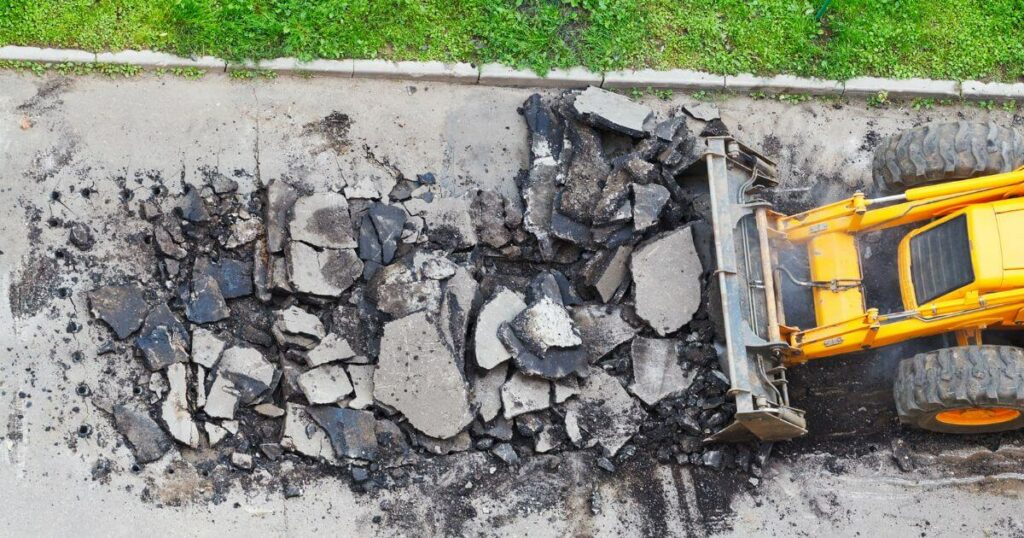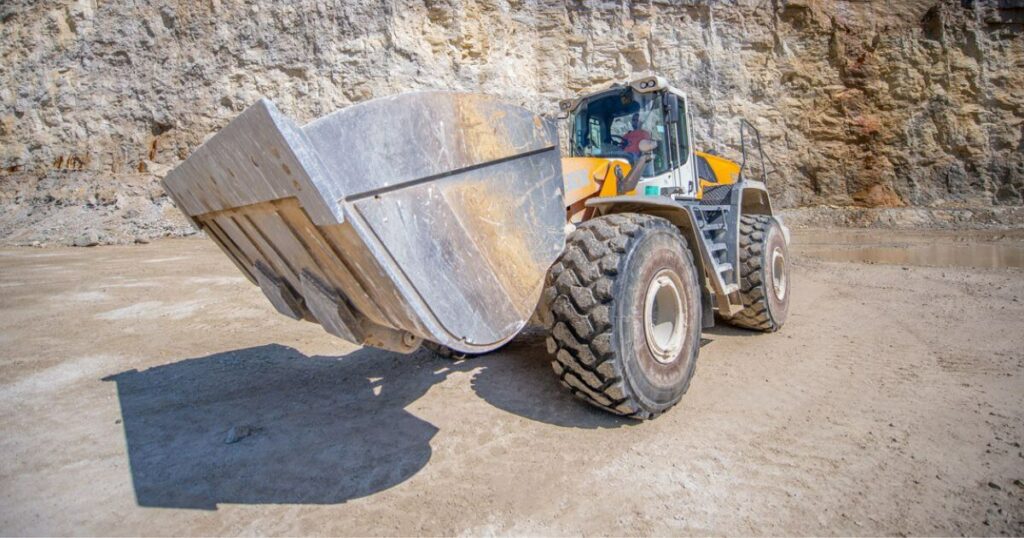Asphalt is a durable and versatile material commonly used for driveways, parking lots, and roads. However, even the most well-constructed asphalt surfaces will eventually deteriorate and require removal. Whether you’re a homeowner, business owner, or contractor, understanding the process of asphalt demolition is essential for ensuring a safe, efficient, and cost-effective project. In this comprehensive guide, we’ll walk you through the step-by-step process of asphalt demolition, explore various methods and equipment, discuss costs, and answer frequently asked questions. Featuring insights from Cornerstone Crushing, your trusted partner for concrete, asphalt, and structure demolition services in Toledo, Ohio, this guide will equip you with the knowledge needed for successful asphalt demolition. Trust Cornerstone Crushing for expert advice and professional services in all aspects of asphalt demolition.
Understanding Asphalt Demolition
Asphalt demolition is a crucial aspect of maintaining and improving paved surfaces. It involves removing damaged or deteriorated asphalt to make way for a new, smooth, and safe surface. Understanding the process, costs, and best practices associated with asphalt demolition can help you make informed decisions when tackling your next project. In this article, we’ll cover everything you need to know about asphalt demolition, from the reasons behind it to the various methods and equipment used, as well as the costs involved and when to consider removing your asphalt surface.
Asphalt Demolition: Definition and Purpose
Asphalt demolition is the process of removing an existing asphalt surface, typically due to damage, deterioration, or the need for a new surface. This process is essential for maintaining the safety, functionality, and aesthetic appeal of paved areas. There are several reasons why you might need to remove an asphalt surface:
- Damage beyond repair: Over time, asphalt surfaces can develop cracks, potholes, and other forms of damage that may be too extensive to repair effectively. In such cases, complete removal and replacement may be the most practical solution.
- Safety concerns: Damaged or uneven asphalt surfaces can pose serious safety risks to pedestrians, cyclists, and vehicles. Removing the old asphalt and replacing it with a new, smooth surface can significantly improve safety.
- Aesthetic improvements: Even if an asphalt surface is structurally sound, it may appear dated or unsightly. Removing the old asphalt and installing a new surface can instantly enhance the visual appeal of your property.
By understanding the reasons behind asphalt demolition, you can better assess when it’s time to consider removing your existing surface and investing in a new one.
Methods of Asphalt Demolition
There are several methods for removing asphalt, each suitable for different project sizes and scopes. The three primary methods are manual removal, jackhammer demolition, and excavator demolition.
Manual Removal
For small asphalt demolition projects, manual removal using hand tools can be a practical and cost-effective option. This method involves using tools such as pickaxes and circular saws to break up and remove the asphalt surface.
Advantages of manual removal:
- Cost-effective for small projects
- Requires minimal equipment investment
- Allows for precise control and selective removal
Disadvantages of manual removal:
- Time-consuming and labor-intensive
- Not suitable for large projects
- Can be physically demanding on workers
Jackhammer Demolition
Jackhammers are powerful, pneumatic tools that can efficiently break up asphalt surfaces. This method is ideal for medium-sized projects or for removing asphalt in areas where an excavator may not have access.
Advantages of jackhammer demolition:
- Faster than manual removal
- More powerful than hand tools
- Can access tight spaces and corners
Disadvantages of jackhammer demolition:
- More expensive than manual removal
- Requires a power source (e.g., air compressor)
- Can be noisy and cause vibrations
Excavator Demolition
For large asphalt demolition projects, using an excavator is often the most efficient and cost-effective method. Excavators are heavy-duty machines equipped with powerful buckets and attachments that can quickly break up and remove large sections of asphalt.
Advantages of excavator demolition:
- Fast and efficient for large projects
- Can handle thick asphalt layers
- Minimizes labor requirements
Disadvantages of excavator demolition:
- More expensive than other methods
- Requires a skilled operator
- May not be suitable for small or confined areas
By understanding the different methods of asphalt demolition, you can choose the most appropriate approach for your project based on its size, scope, and specific requirements.

Step-by-Step Asphalt Demolition Process
Now that you’re familiar with the various methods of asphalt demolition, let’s walk through the step-by-step process of removing an asphalt surface.
Determine the Appropriate Method
The first step in any asphalt demolition project is to assess the size and scope of the work and determine the most suitable removal method. Consider factors such as the area’s size, accessibility, and the asphalt’s thickness when choosing between manual removal, jackhammer demolition, or excavator demolition.
Questions to ask when determining the appropriate method:
- How large is the area that needs to be removed?
- Are there any accessibility limitations (e.g., tight corners, narrow spaces)?
- What is the thickness of the asphalt layer?
- What is your budget for the project?
Once you’ve answered these questions, you can select the method that best fits your project’s needs and constraints.
Break and Remove the Asphalt
After choosing the appropriate demolition method, it’s time to begin breaking up and removing the asphalt surface. The specific techniques will vary depending on the method you’ve selected.
For manual removal:
- Use a pickaxe or circular saw to create fracture lines in the asphalt.
- Break the asphalt into smaller, manageable pieces.
- Use a pry bar to lift and remove the broken asphalt pieces.
For jackhammer demolition:
- Ensure the jackhammer is properly connected to a power source (e.g., air compressor).
- Begin breaking the asphalt at the edges of the area to be removed.
- Work your way inward, breaking the asphalt into smaller pieces.
- Use a pry bar or shovel to remove the broken asphalt.
For excavator demolition:
- Position the excavator at the edge of the asphalt area to be removed.
- Use the excavator’s bucket or attachment to break up the asphalt.
- Work systematically, breaking the asphalt into manageable pieces.
- Use the excavator to scoop up and remove the broken asphalt.
Regardless of the method used, it’s essential to wear appropriate safety gear, such as hard hats, eye protection, and steel-toed boots, to ensure a safe working environment.
Proper Disposal of Removed Asphalt
Once the asphalt has been broken up and removed, it’s crucial to dispose of it properly. Asphalt recycling is an environmentally friendly and cost-effective option that should be considered whenever possible.
Benefits of recycling removed asphalt:
- Reduces waste sent to landfills
- Conserves natural resources
- Can be used in the production of new asphalt mixes
- May lower disposal costs
To recycle your removed asphalt, follow these steps:
- Locate a local asphalt recycling facility or contact your local waste management company for guidance.
- Arrange for transportation of the removed asphalt to the recycling facility.
- Ensure that the recycling facility accepts the type and quantity of asphalt you have.
If recycling is not an option, you’ll need to dispose of the asphalt in accordance with local regulations. Contact your local waste management company or municipal authorities for guidance on proper disposal procedures.
Costs of Asphalt Demolition
The cost of asphalt demolition can vary significantly depending on several factors, such as the size of the project, accessibility, and the difficulty of removal. On average, you can expect to pay between $1 and $3 per square foot for asphalt demolition.
Factors that can impact the cost of asphalt demolition include:
- Project size: Larger projects generally have a lower cost per square foot due to economies of scale.
- Accessibility: Projects with limited access or tight spaces may require more labor and specialized equipment, increasing costs.
- Difficulty of removal: Thicker asphalt layers or surfaces with extensive damage may be more challenging and time-consuming to remove, resulting in higher costs.
- Local living costs: Labor and disposal costs can vary depending on the location of your project.
To get an accurate estimate for your asphalt demolition project, it’s best to contact a professional contractor who can assess your specific needs and provide a customized quote.
When to Remove Asphalt
Knowing when to remove your asphalt surface is essential for maintaining safety, functionality, and aesthetic appeal. Here are some signs that it may be time to consider asphalt demolition:
- Deep cracks: If your asphalt surface has numerous deep cracks that are more than a quarter-inch wide, it may be beyond repair and require removal.
- Unevenness: Uneven surfaces can pose safety hazards and indicate underlying structural issues that may necessitate asphalt demolition.
- Sunken areas: Depressions or sunken areas in your asphalt surface can collect water, leading to further damage and potential safety risks.
- Potholes: Large or numerous potholes can be difficult to repair effectively and may signal the need for complete asphalt removal and replacement.
As a general rule, if more than 25-35% of your asphalt surface is damaged or showing signs of severe wear, it may be more cost-effective to remove and replace the entire surface rather than attempting extensive repairs.
Frequently Asked Questions
What is the best method for removing asphalt?
The best method for removing asphalt depends on the size and scope of your project. For small projects, manual removal with hand tools may be sufficient. Medium-sized projects may benefit from jackhammer demolition, while large projects are often best suited for excavator demolition.
How long does an asphalt driveway last before needing replacement?
On average, an asphalt driveway can last between 20 and 30 years with proper maintenance. However, factors such as climate, usage, and maintenance practices can impact the lifespan of your driveway.
Should I choose concrete or asphalt for my driveway?
Both concrete and asphalt have their advantages and disadvantages. Asphalt is generally less expensive and faster to install, but it requires more frequent maintenance. Concrete is more durable and requires less maintenance, but it is typically more expensive and can be prone to cracking in harsh climates.
What are the benefits of recycling removed asphalt?
Recycling removed asphalt offers several benefits, including reducing waste sent to landfills, conserving natural resources, and potentially lowering disposal costs. Recycled asphalt can also be used in the production of new asphalt mixes, reducing the need for virgin materials.
How can I maintain my asphalt driveway to extend its lifespan?
Regular maintenance can help extend the life of your asphalt driveway. Some key maintenance practices include:
- Sealing cracks and filling potholes promptly
- Applying a sealcoat every 2-3 years
- Keeping the surface clean and free of debris
- Avoiding excessive weight or heavy equipment on the surface
By following these maintenance practices, you can help prevent damage and extend the life of your asphalt driveway.

Trust Cornerstone Crushing with Your Asphalt Removal
Asphalt demolition is a crucial process for maintaining and improving paved surfaces. By understanding the various methods, costs, and best practices associated with asphalt removal, you can make informed decisions when tackling your next project. Whether you choose manual removal, jackhammer demolition, or excavator demolition, it’s essential to prioritize safety, efficiency, and proper disposal to ensure a successful outcome.
When it’s time to remove your old, damaged asphalt, trust the experts at Cornerstone Crushing. Our experienced team has the knowledge and equipment to handle projects of any size, ensuring efficient demolition and environmentally-friendly disposal. Contact us today for a free consultation, and let us help you create a safer, more attractive surface that will serve you well for years to come.


